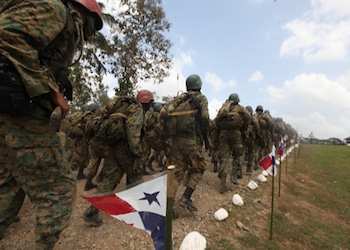When President Barack Obama makes his first visit to Central America next week, Panama will most likely not be on the list of topics. While 75 tons of cocaine were seized there last year, far above the amount intercepted by its neighbors, the country sees less of the violence currently afflicting its northern neighbors on the drug trail to Mexico and the U.S. InSight wonders whether it is just a matter of time.
Panama is often described as being at “the mouth of funnel,” a reference to its shared border with Colombia, the world’s largest producer of cocaine. Security forces seized 75 tons of cocaine last year, the most, by far, in the region. In comparison, according to the U.S. State Department, police and naval forces seized 626 kilos of cocaine in El Salvador last year, a transit country where drug violence and homicide levels are far higher.
The country has long served as a respite, meeting place, and center for laundering money, but rarely as a home for large drug trafficking groups. While Mexican and Colombian players are present, they reportedly keep a low profile. Gang activity is rising but still in check.
The largest criminal group with a permanent presence in Panama is the Revolutionary Armed Forces of Colombia (Fuerzas Armadas Revolucionarias de Colombia – FARC), which takes refuge in the rural border region of Darien. The FARC uses the so-called Darien Gap, a huge swath of jungle that separates Panama from Colombia, as a storage area and staging point for moving cocaine north.
The Darien is barren and unpopulated, allowing the rebels to work in relative peace. This may, at times, be aided by winks and nods coming from Panamian officials, who say it’s not their job to fight the guerrillas. Indeed, previous Panamanian administrations have been dogged by allegations that they struck non-aggression pacts with the rebels.
Nevertheless, it’s hard for Panama to avoid trouble. The country’s proximity to Colombia, its access to two oceans, and its regular shipping traffic make it a vital corridor and launching pad for drugs moving north. And traffickers have been using Panama’s extensive coastline for three decades, in particular the southeast Chepo river basin and the northern province of Veraguas.
Since 2007, however, authorities have been tracking a rise in drug traffic, seizures, and gang violence which could be inter-related. According to the U.S. State Department’s most recent report, the amount of cocaine departing northern Panama to Central America nearly doubled in 2010. The main Panamanian force responsible for drug interdiction, the National Naval Air Service, known as SENAN, also reported seizing 4.6 tons of cocaine through January 2011, a record for the agency.
There are also indications that violence related to organized crime is rising. The national homicide rate has doubled since 2006, reaching a level of 23.8 per 100,000 inhabitants. While that’s below its Central American neighbors, it’s on a par with Mexico’s. And President Ricardo Martinelli said that more than 50 percent of homicides in Panama are related to the drug trade.
Street gangs have also proliferated, tripling since 2005. Like its northern neighbors, most of Panama’s violence seems to involve clashes between the smaller gangs, competing for space in the domestic drug trade that has grown since large drug trafficking gangs began using them as cheap labor and paying them in merchandise. But for now, there is little indication that ‘pandillas’ are doing more than managing the street-level distribution of drugs, in comparison to El Salvador, where the Mara Salvatrucha (MS-13) have moved towards becoming more deeply involved in international trafficking.
Panama also routinely struggles with corruption scandals, most of them involving public contracts and pork barrel spending. The U.S. State Department report noted that SENAN, along with other security agencies like the National Police and the Frontier Police, known as SENAFRONT, have been “penetrated” by drug-trafficking organizations (DTOs).
In one high profile case, the chief of police of the Colon province was suspended from duty in September after traces of cocaine were found in vehicles under his command. Colon is where the Panama Canal connects to the Atlantic and is a hotspot for drug smuggling. Other efforts to root out corruption in the SENAN were derailed by frequent changes in top personnel. The head of SENAN resigned in March, citing “personal reasons,” and his replacement would also leave office just eight months later.
To be sure, official investigations into corruption cases frequently stall or go nowhere due to political infighting. In one controversial case, President Martinelli edged out the country’s chief prosecutor general in December 2009, apparently because she refused to go along with Martinelli’s efforts to harass his political rivals.
Meanwhile, the country’s anti-corruption czar, Fernando Nuñez Fabrega, has displayed little interest in shining a light on cases involving drug money. The former head of maritime interdiction, Ricardo Traad Porras, was absolved of money laundering charges in January 2010. Another investigation against ex-president Ernesto Perez Balladares, who is accused of money laundering and is under house arrest, is also languishing in the courts.
With an estimated 11 million containers moving through the Panama Canal every year, Panama will remain an attractive transit country for drug traffickers, sitting astride South and Central America. For now, the country appears to have avoided the violence prevalent in countries like El Salvador, Guatemala and Honduras.
But if local ‘pandillas’ move towards becoming more involved in the international trafficking of drugs, or if turf wars explode over control of this important corridor, as has already happened with its northern neighbors, conditions on the ground in Panama could quickly change.

